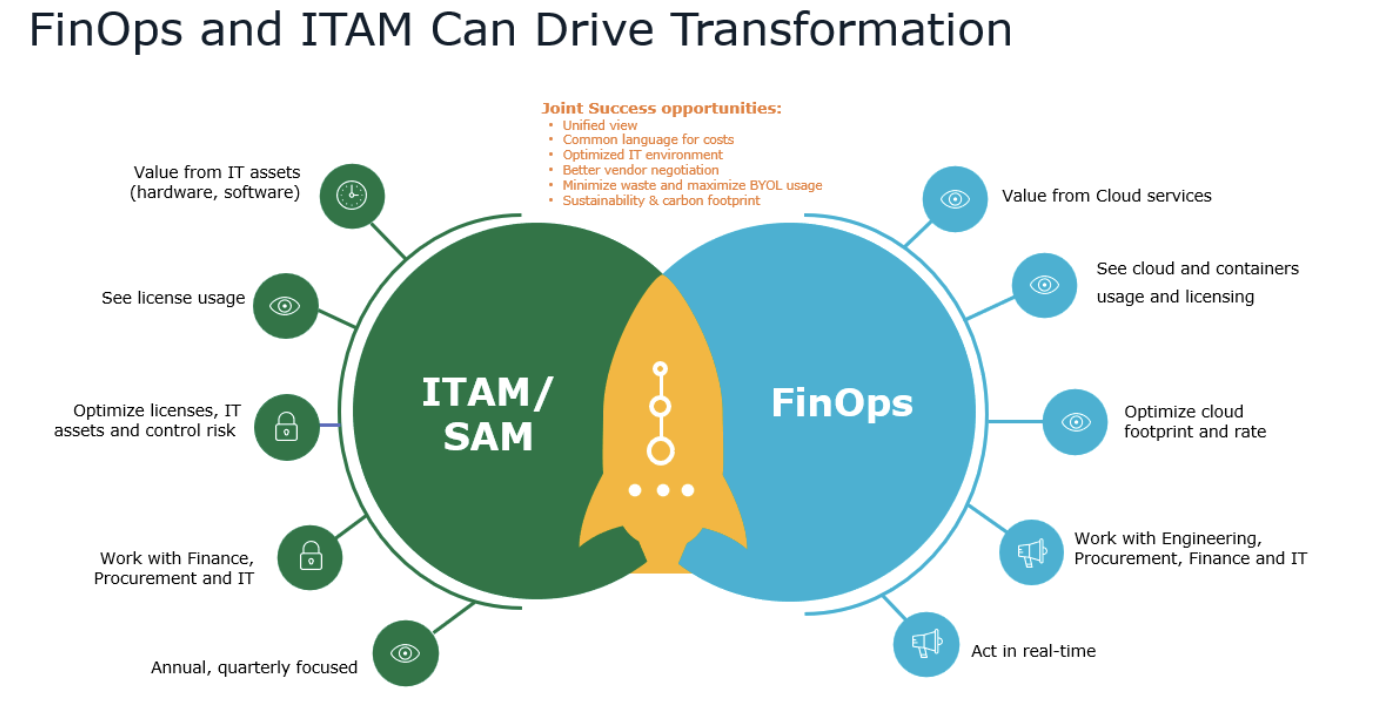6 Collaborative Use Cases for FinOps and ITAM Teams

Managing costs and resources efficiently has become paramount for organizations seeking to maintain competitiveness. Financial Operations (FinOps) and IT Asset Management are two distinct but interconnected fields that play a vital role in optimizing costs and resources. In this second article in a series on the intersection of FinOps and ITAM, we discuss crucial use cases, demonstrating how their collaboration can lead to streamlined processes and enhanced cost management.
These use cases are from the framework the FinOps Foundation has established on how ITAM intersects with FinOps capabilities.
Use case #1: Cost allocation
Cost allocation is a fundamental aspect of financial management, and it’s where FinOps and ITAM converge effectively.
FinOps cost allocation activities:
- Developing strategic naming standards and hierarchical groupings.
- Defining governance standards for various groups.
- Tagging groups such as by team, project, application, region, etc.
- Reporting on key financial metrics such as cost per group/user.
- Allocating costs with any associated commitment-based discounts.
ITAM cost allocation activities:
- Using naming standards for license allocation.
- Applying cloud naming standards for Bring Your Own License (BYOL).
- Developing reporting standards for BYOL usage.
FinOps and ITAM intersection – Cost allocation:
- Shared understanding and utilization of naming standards.
- Overlaps in areas like BYOL and cloud service provider (CSP) marketplace, necessitating collaboration for optimal cost allocation.
Use case #2: Managing shared costs
Shared costs present unique challenges, but collaboration between FinOps and ITAM can ensure equitable distribution.
FinOps activities with managing shared costs:
- Identifying shared cost types.
- Establishing mechanisms for dividing shared costs.
- Applying shared cost models.
- Reporting on shared costs.
ITAM activities for managing shared costs:
- Collaborating with Finance to establish cost-sharing methodologies.
- Agreeing on a methodology for distributing monthly costs.
FinOps and ITAM intersection – Managing shared costs:
- Overlaps in support costs (CSP or software).
- Collaborating with application owners for shared cost allocation.
- Handling products with prepaid lump sums and variable monthly usage costs.
Use case #3: Managing anomalies
Identifying and managing anomalies is crucial to preventing financial leakages and ensuring IT organizational processes are followed.
FinOps activities with managing anomalies:
- Establishing an anomaly management process.
- Detecting, documenting, and communicating about the peaks and valleys of cloud activity.
- Generating alert reports to surface anomalous spending.
ITAM activities with managing anomalies:
- Conducting regular license compliance reviews (for example, when cloud spending spikes, it’s possible the associated license use spikes as well. It becomes a difficult situation when you don’t have enough licenses to cover the increase, leading you to fall out of compliance).
- Investigating license shortages and underutilization.
- Addressing unauthorized/unsupported applications.
FinOps and ITAM intersection – Managing anomalies:
- Managing license usage, particularly overages.
- Addressing unauthorized/unsupported use of services and products.
- Rightsizing licenses in response to overages.

Use case #4: Forecasting
FinOps and ITAM come together to make stronger forecasts for the business as a whole.
FinOps activities with forecasting:
- Collaborating with multiple teams to develop a forecasting methodology and process.
- Leveraging historical data and future plans to create forecasts.
- Coordinating with budget leaders to ensure budgets align with business goals.
- Tracking and reporting on KPIs.
ITAM activities with forecasting:
- Projecting cost increases, reductions, and requirements based on license reviews.
- Collaborating with stakeholders to determine license requirements and cost adjustments.
FinOps and ITAM intersection – Forecasting:
- ITAM engages in forecasting, particularly related to licenses, while cloud forecasting is generally outside its scope.
- Overlaps occur in areas like BYOL, CSP marketplace, and standalone SaaS, requiring collaborative planning and forecasting.
Use case #5: Budget management
ITAM and FinOps teams can work together to optimize budgets for greater efficiency.
FinOps activities with budget management:
- Planning with budget leaders for efficient budget plans.
- Tracking and reporting KPIs to monitor cloud spend versus budget.
- Exploring optimization opportunities and overspending by alerting teams projected to exceed budgets.
- Communicating with leadership when underspending is expected.
ITAM activities on budget management:
- Advising Finance on budget expectations based on licensing insights.
- Conducting annual reviews of renewal expenditures.
FinOps and ITAM intersection – Budget management:
- FinOps collaborates with ITAM to ensure license and consumption-based usage aligns with budget expectations.
Use case #6: Workload management and automation
Workload management and automation prioritize efficient resource usage by ensuring that resources are active only when necessary.
FinOps activities with workload management and automation:
- Collaborating with application owners to tag resources effectively.
- Communication of performance statistics regarding automation and non-tagged resources.
ITAM activities with workload management and automation:
- Establishing protocols for transparent communication of performance metrics related to resource usage and automation.
FinOps and ITAM intersection – Workload management and automation:
- ITAM reviews license usage and collaborated with FinOps to clean up temporary or abandoned assets.
- Collaboration ensures that licensed assets align with elasticity and scaling considerations, factoring in license rights and entitlements.
The intersection of FinOps and ITAM offers a powerful synergy for organizations seeking to enhance their cost management efforts. By leveraging the strengths of both disciplines, organizations navigate the complexities of cost allocation, data analysis, anomaly management, shared cost distribution, and more. This is the second post in a series exploring the intersection of FinOps and ITAM.
Read the next post in this series, How FinOps and ITAM Teams Can Work Together in Real-Life Scenarios.